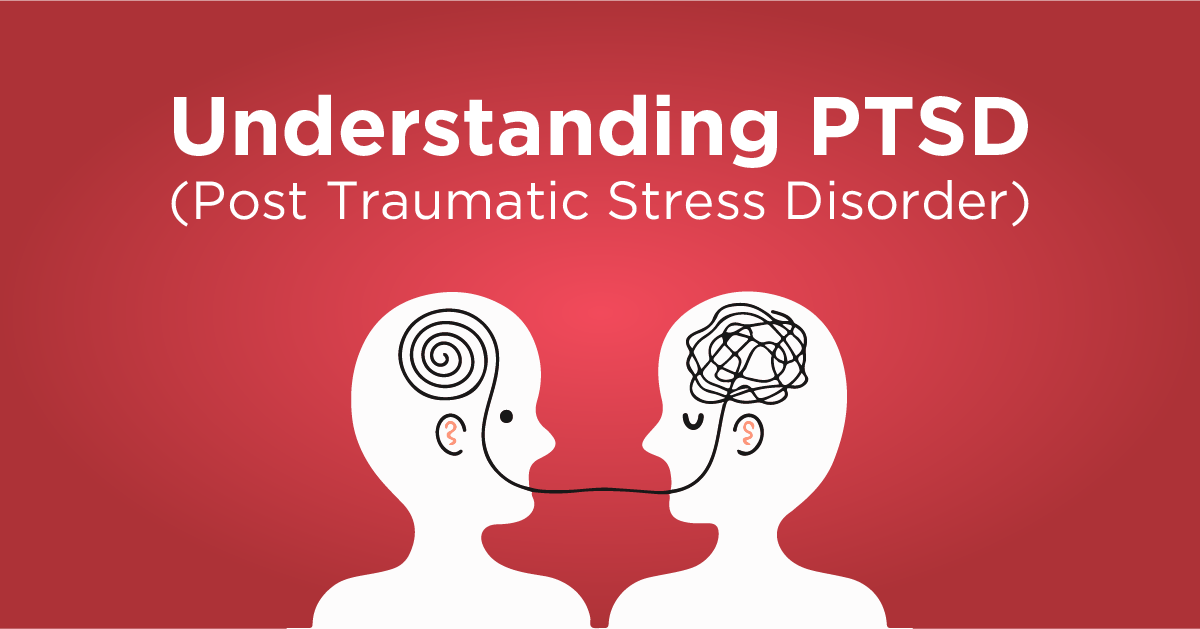What is PTSD?
Post-traumatic stress disorder (PTSD) is a mental health problem a person may develop after experiencing traumatic events. PTSD was first diagnosed in war veterans and was often called a shell shock.
It is a group of stress symptoms that can develop after one (or sometimes more than one) traumatic event. For example, it could be a serious injury, a death, or different forms of violence. Or after repeated exposure to trauma.
Feelings of fear, sadness, anger and grief are really common after a traumatic event; it’s really a part of our natural response to danger to keep us safe. What makes PTSD different is that the stress reaction is more persistent, it causes significant distress and interferes with everyday functioning – so things like work, relationships, socialising or even engaging in hobbies or activities that they would have otherwise enjoyed.
While some people have heard about this disorder, there are lots of misconceptions about PTSD. For example, people may wrongly assume it means the person is ‘dwelling’ on past events. They might even suggest that the person suffering should ‘get over it’ or ‘move on. However, having PTSD isn’t a choice or a sign of weakness. Moreover, it is also important to remember that you are not alone

Direct and indirect exposure – what are the differences?
People can experience PTSD after witnessing a traumatic event happening to others, or by experiencing the traumatic event themselves.
Direct exposure is when an individual actually experiences a personal trauma or witnesses a traumatic event. Examples include being physically assaulted at work, or seeing the impact of a car accident. And it can even include exposure to large-scale natural disasters.
In contrast, indirect exposure is when an individual hears or learns about a traumatic event, so more secondhand. There are lots of different types of traumatic events and people respond to them in different ways.
Many people who are actually exposed to a traumatic event, whether its direct or indirect, don’t necessarily develop PTSD and the way people respond is really dependent on their personal experience of past traumas and mental health history,’ she adds.

What are the causes of PTSD?
There are many different harmful or life-threatening events that might cause someone to develop PTSD. For example:
- Serious accidents
- Military combat
- Violent personal assault (sexual assault, physical attack, abuse, robbery, mugging)
- Being taken, hostage
- Terrorist attack
- Being a prisoner-of-war
- Natural or man-made disasters
- Being diagnosed with a life-threatening illness.
- Even hearing about the unexpected injury or violent death of a family member or close friend can start PTSD.
Some of these events are one-time incidents, like natural disasters or car accidents. Other traumas occur continuously, like coping with an illness or recurring abuse in childhood. Unfortunately, some traumatic incidents are overlooked, like medical trauma, trauma from childbirth, or major surgery.
In addition to this, not everyone who has experienced a traumatic event will develop PTSD. There is no way of knowing who will develop post-traumatic stress disorder after a traumatizing event. The chances of developing it and how severe it is vary based on things like personality, history of mental health issues, social support, family history, childhood experiences, current stress levels, and the nature of the traumatic event.
These horrifying experiences trigger an extreme amount of fear and an overwhelming amount of stress. While some people can recover over time with little to no symptoms, some may feel “stuck” in this constant state of fear and danger, without any real threat present. When this occurs, it may be a sign of PTSD or trauma-related anxiety.

Types of PTSD
Two conditions are closely related to PTSD:
- Acute Stress Disorder: This is a short-term mental health condition that can occur within the first month after experiencing a traumatic event. Symptoms lasting longer than four weeks may meet the criteria for PTSD.
- Complex PTSD (CPTSD): This is a mental health condition that can develop if you experience chronic (long-term) trauma. Examples of chronic trauma include long-term child physical or sexual abuse, long-term domestic violence and war. People with CPTSD typically have PTSD symptoms in addition to extensive issues with emotion regulation, sense of self and relationships.
Symptoms and Causes
To receive a PTSD diagnosis, symptoms must last for more than a month and must cause significant distress or issues in your daily functioning. The symptoms of PTSD fall into four categories:
Intrusion:
- Intrusive thoughts, such as repeated, involuntary memories.
- Nightmares.
- Flashbacks of the traumatic event, which can be very vivid and feel real.
Avoidance:
- Avoiding reminders of the traumatic event, like people, places, activities, things and situations.
- Avoiding remembering or thinking about the traumatic event.
- Avoiding talking about what happened or how you feel about it.
Changes in thinking and mood:
- Ongoing fear, horror, anger, guilt or shame.
- Memory loss of important aspects of the traumatic event.
- Ongoing negative and distorted thoughts and feelings about yourself or others.
- Distorted thoughts about the cause or effects of the event that lead to wrongly blaming yourself or others.
- Feeling detached from others.
- No longer enjoying activities you once did.
- Being unable to experience positive emotions.
Changes in arousal and reactivity:
- Irritability and angry outbursts.
- Reckless or self-destructive behavior.
- Being overly watchful of your surroundings (hypervigilance).
- Being easily startled.
- Problems concentrating or sleeping.
Symptoms of PTSD in children
Children with PTSD may have difficulty expressing how they’re feeling or they may have experienced trauma that you don’t know about. They may seem restless, fidgety, or have trouble paying attention and staying organized.
These symptoms can be confused with symptoms of attention-deficit/hyperactivity disorder (ADHD). Because of this, it’s important to take your child to a specialist (like a child psychologist) who has experience in diagnosing PTSD.

Diagnosis
When PTSD symptoms listed above last for more than a month and cause significant distress or impairment, you may be diagnosed with PTSD.
Usually, mental healthcare providers will diagnose PTSD, including psychiatrists, psychiatric nurse practitioners, psychologists, social workers, and counselors. Family medicine doctors, also known as primary care physicians, can also diagnose the condition.
Remember that there’s no need to check off every box for a diagnosis of PTSD. You only need to experience a certain number of symptoms from each category for an official diagnosis from a qualified mental health professional.
They’ll review your symptoms and history with you to determine your diagnosis and what you need to cope and recover.

Treatment
Fortunately, many research-backed treatments can help people living with PTSD cope with symptoms and begin to recover. Effective treatments for PTSD include:
Cognitive Behavioral Therapy
Cognitive Behavioral Therapy (CBT) helps you learn how to recognize thought patterns that fuel negative beliefs about yourself, deal with reminders and emotions associated with the trauma, and help reduce maladaptive behaviors associated with PTSD.
Exposure Therapy
Exposure Therapy repeatedly exposes you to memories and reminders of trauma to learn how to cope effectively with distressing symptoms of PTSD like anxiety and avoidance.
Eye Movement Desensitization and Reprocessing
Eye movement desensitization and reprocessing (EMDR) allows you to process traumatic memories in a new way with the help of guided eye movements.
Medication
Medication can help ease symptoms of PTSD and may improve your ability to participate in psychotherapy.
You may be prescribed antidepressants such as selective serotonin reuptake inhibitors (SSRI) like Zoloft (sertraline) or Paxil (paroxetine), anti-anxiety medications (though generally only for a short period due to the potential for dependence or abuse), or other medications to help reduce sleep disturbances like nightmares.
Psychedelic Therapy
Certain psychedelic agents, such as ketamine, psylocibin, and MDMA, show promise in the treatment of PTSD. These medications change the way the brain processes fear, and can also help treat co-existing mental health disorders such as depression.
Complementary Therapies
Additionally, there are several promising alternative therapies to consider adding to your treatment regimen, such as animal-assisted therapy and trauma-sensitive yoga.















1 Comment